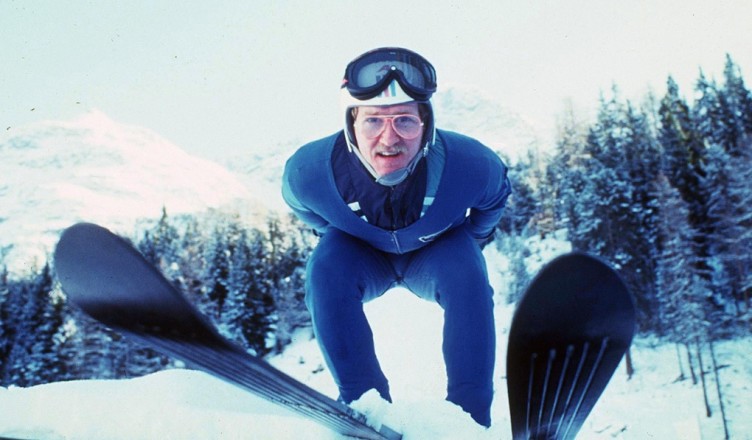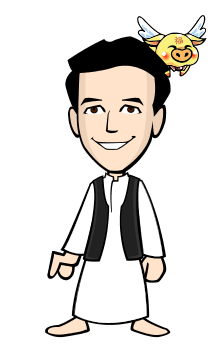
“Getting there was my greatest achievement.”
Michael “Eddie” Edwards, the real “Eddie the Eagle,” describes his ascent to the 1988 Winter Olympics in Calgary, representing the UK as a ski jumper. Eddie’s life story is at the heart of a new movie, starring Hugh Jackman, Christopher Walken, and Taron Egerton as Eddie. “Eddie the Eagle” will open in the U.S. on February 26, 2016.
The movie’s synopsis—via ComingSoon—reads like a sports fairytale:
Inspired by true events, “Eddie the Eagle” is a feel-good story about Michael “Eddie” Edwards… an unlikely but courageous British ski jumper who never stopped believing in himself – even as an entire nation was counting him out. With the help of a rebellious and charismatic coach (played by Hugh Jackman), Eddie takes on the establishment and wins the hearts of sports fans around the world by making an improbable and historic showing at the 1988 Calgary Winter Olympics.
Edwards is the ultimate underdog, a loveable loser who fumbled his way to Calgary. In the movie, Eddie’s character has dreamed of being an Olympian since childhood. In real life? Michael “Eddie” Edwards told the BBC that “only 10 to 15%” of the film, directed by Dexter Fletcher, is “based on my life.” Nonetheless, the story is riveting, because Edwards himself became a hero to many.
 themovieblog.com/wp-content/uploads/2015/12/1214773_Eddie-the-Eagle-first-look.jpg 636w" alt="1214773_Eddie-the-Eagle-first-look" width="315" height="214" />Hugh Jackman, who plays Edwards’ coach and pal, stated, “Eddie the Eagle is a folk hero. He’s British, but Eddie embodies that quintessential have-a-go quality that Aussies love. He really just went for it as the whole world watched. …
themovieblog.com/wp-content/uploads/2015/12/1214773_Eddie-the-Eagle-first-look.jpg 636w" alt="1214773_Eddie-the-Eagle-first-look" width="315" height="214" />Hugh Jackman, who plays Edwards’ coach and pal, stated, “Eddie the Eagle is a folk hero. He’s British, but Eddie embodies that quintessential have-a-go quality that Aussies love. He really just went for it as the whole world watched. …
“Every kid should see this movie, because it reminds people that you don’t have to win to be a winner. Eddie the Eagle might not have ended up on the medal podium, but he was victorious. It’s a story of a man who had a dream, and nothing was going to stop him.”
Edwards has been the subject of much commentary, even decades after his Olympic debut. UK’s The Guardianran a feature about him in 2014, called “Reappraising Eddie ‘The Eagle’ Edwards.” (The article had originally appeared on That 1980s Sports Blog.) The post chronicles Edwards’ journey to Calgary: even without Hollywood’s embellishments, it’s the story of a sportsman who went against the odds to reach his dream.
Edwards just missed qualifying for the 1984 Olympics as downhill skier. In 1986, he made the decision to switch to ski jumping: “I didn’t have much money, so thought I’d better find something cheaper to do. I went along to the ski jumps [in Lake Placid, where he had been training] and thought: that looks alright.”
The story continues:
Edwards’ European tour was not a bundle of laughs. Penniless, he had to take up a variety of part-time jobs, including babysitting, cutting grass, working in hotels and cooking. At one point he ended up staying in a Finnish mental health hospital paying £1 a night for the privilege – it was there that he would discover that he had made the Olympic team – and such was his shortage of money that on another occasion he broke his jaw, but could not afford the medical bills, so tied it up himself with a pillowcase and simply carried on.
Edwards ploughed on, despite difficulties. He famously wore glasses so thick under his goggles that he often couldn’t even see where he was going. His helmet was tied to his head with a piece of string, and he wore six pairs of socks to fit into his too-large secondhand boots. But he never gave up. By the time he reached Calgary, he was a bit stunned to find a small fan club, along with the press, waiting to meet him at the airport.
When it came time for his first run, he said his usual prayer: “May I survive and come through this intact.” As he made the jump, the crowds cheered, “Eddie! Eddie!”
Not everyone was as supportive, though. Journalists referred to him as “a clown,” and one even wrote, “In [the] future, competitors should be required to meet qualifying standards, before they are allowed to enter.” Just a few years later, the IOC established something called the “Eddie the Eagle Rule,” requiring all participants in the Olympics to be the top athletes in their fields.
But the public was on his side. When Edwards, who came in last place in the ski jump competition, returned to England he was met by some 10,000 adoring fans. He’s said to have earned more than $1 million dollars that year alone for endorsements and appearances. The plasterer from Cheltenham had made it—he’d achieved his dream of becoming an Olympian, and become a folk hero as a result.
“Eddie the Eagle” promises to tell Edwards’ story with aplomb. Its star, the up and coming Taron Egerton, was born a year after the 1988 Olympics, yet portrays Edwards to a T—the squinting, bumbling, yet ever-hopeful sportsman. Edwards has indeed set an example of sportsmanship that will inspire his fans—those who remember the 1988 Olympics as well as those who are hearing Edwards’ story for the first time.



